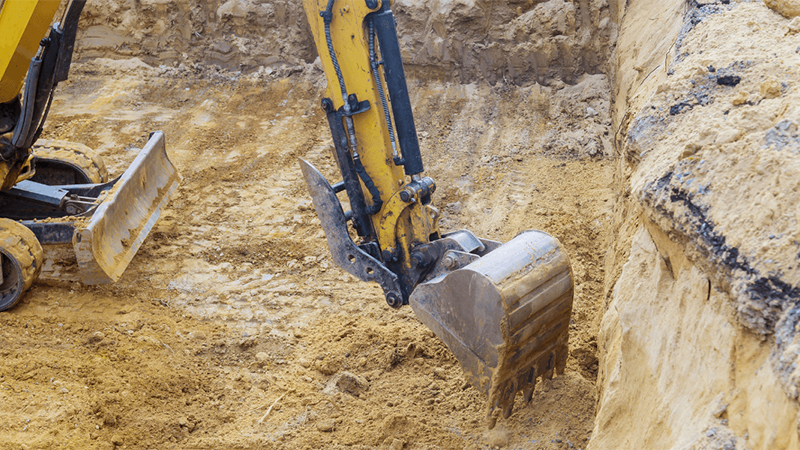Excavation Cost for Foundation Work – What to Expect & How to Save

Breaking ground on a new construction project?
Before laying a concrete slab or foundation walls, excavation comes first, and it’s more than just digging. Excavation cost for foundation work depends on several factors, including soil type and job site conditions. Costs range from a few thousand dollars to over $10,000, factoring in dirt removal, drainage issues, and site cleanup.
Some excavation contractors charge per cubic yard, while others price the entire job based on site conditions. Unexpected surprises like large boulders or specialized equipment can drive up costs fast.
This guide breaks down land or rock excavation costs in simple terms. Learn about cost factors, labor costs, and smart ways to save money. From basement excavation to swimming pools, get a rough estimate of what to expect before the digging starts.
Key Takeaways
- Excavation costs vary based on soil type, depth, and unexpected obstacles.
- Smart planning helps cut costs by bundling projects, reusing soil, and choosing the right contractor.
- A solid excavation plan sets the stage for a strong and stable foundation.
The Excavation Process – What Goes Into Digging a Foundation?
Digging might seem simple, but foundation excavation is anything but. It takes more than a big machine scooping dirt to get the job done right.
The right excavation equipment, a well-planned approach, and a good grasp of site conditions all play a role. Cutting corners here can lead to drainage issues, foundation shifting, and costly fixes later.
- Site preparation: Before breaking ground, the area must be cleared of trees, debris, and any existing structures. Land clearing makes way for proper yard grading and creates space for heavy machinery to operate.
- Soil testing: The type of soil on your job site affects the difficulty of excavation work. Loose soil may shift after construction, while rocky terrain can require specialized equipment to break through.
- Equipment selection: Not all projects need a full-size excavator. Some require smaller dump trucks for tight spaces, while deep digs might need heavy equipment like bulldozers or trenchers.
- Safety measures: Digging too close to underground utility lines can be dangerous and costly. Contractors mark utilities and set up protective barriers to prevent collapses during earth excavation.
Excavation stages and how they impact cost
Each stage of excavation comes with different cost factors, from the depth of the dig to the equipment needed.
- Topsoil removal: The first layer of excavated soil is often rich and reusable, but moving it adds to dirt removal costs.
- Earth excavation: Soil is removed to create a stable base for the foundation. Deeper digs for new basements or crawl spaces take more time and labor.
- Rock excavation: If the site contains large boulders, blasting or jackhammering may be needed, which increases the total cost.
- Trenching: Essential for septic tanks, drainage systems, and foundation footings. Depth and length affect project costs, with some sites needing specialized equipment to dig properly.
Excavation Cost Breakdown – Where Does Your Money Go?

Excavation might seem like a straightforward part of a new construction project, but costs can add up quickly. Excavation contractors consider everything from soil type to underground obstructions, and pricing models can vary based on the excavation project size and complexity.
Pricing models: How contractors charge for excavation
Most excavation companies use one of three pricing methods:
- Hourly rate: Expect to pay between $100 and $300 per hour, depending on the size of the heavy equipment used. Larger machines may move more dirt faster, but they come with higher operating costs.
- Per cubic yard pricing: Many contractors charge $2.50 to $15.00 per cubic yard based on factors like land excavation costs, job site accessibility, and project costs. The more cubic yards of dirt removed, the higher the price.
- Flat project fee: Some jobs, especially larger projects like residential excavation or foundation excavation, come with a single cost estimate. This is often the case for in-ground pools, crawl spaces, and concrete patios.
Factors that increase cost
Certain conditions can push excavation costs higher:
- Difficult terrain: Rocky soil or large boulders require specialized equipment, increasing labor time and fuel usage.
- Hard-to-reach sites: If an existing house or tight space prevents heavy machinery from accessing the area, smaller dump trucks or additional labor may be required.
- Deeper digging: Excavating for a new basement or crawl space requires removing more dirt, which adds to dirt removal costs.
The hidden costs of excavation
Beyond the obvious expenses, several additional costs can affect your budget:
- Permit fees: Most areas require permits for excavation. Fees range from $50 to $400, depending on local regulations.
- Soil disposal: Excavated soil must go somewhere. Hauling it away costs $8 to $25 per cubic yard, depending on land survey findings and disposal site distance.
- Site preparation and yard grading: Clearing trees, removing debris, and leveling the area can add $500 to $5,000 to the total cost.
- Unexpected obstacles: Underground utility lines, poor soil conditions, or unmarked structures can require extra work, increasing labor time and excavation costs.
Comparing Costs for Different Foundation Projects
The type of foundation you choose plays a major role in excavation costs. Some require minimal digging, while others involve moving large amounts of soil, increasing land excavation costs and labor. Below is a breakdown of typical foundation excavation costs:
- Slab foundation: The most affordable option, costing $1,500 to $6,000. Requires minimal excavation work, mainly for leveling and yard grading.
- Crawl space: Falls in the mid-range at $3,000 to $10,000. More digging is required than a slab, but less than a full basement.
- Basement excavation: One of the most expensive options at $5,000 to $15,000, as it involves removing large amounts of soil, site cleanup, and often correcting drainage issues. Land surveys may also be required to check for underground obstructions like utility lines.
- Hillside foundation: Costs $5,000 to $20,000+, depending on the slope and need for erosion control. Requires extra work to stabilize the land, sometimes using retaining walls and specialized excavation equipment.
How depth and soil type affect pricing
The deeper the excavation, the higher the project costs. Digging for a new construction slab requires far less effort than excavating for a basement. More depth means more labor, fuel, and heavy machinery, all of which increase the final price.
If the site has underground obstructions like old foundations or buried debris, excavation can take longer, adding to labor costs.
Soil conditions also play a big role:
- Soft soil: The easiest to dig through, keeping costs low.
- Clay or wet soil: Requires additional reinforcement to prevent shifting, increasing excavation expenses.
- Rocky terrain: The most difficult to excavate. If large rocks or bedrock are present, contractors may need blasting or jackhammering, which significantly raises the total cost.
How to Save Money on Excavation Costs

Excavation is a necessary step in any construction work, but that doesn’t mean it has to break the bank. With some planning and smart decisions, you can reduce excavation costs without sacrificing quality.
Smart budgeting strategies
- Schedule excavation during the off-season: Many excavation companies have slower months in winter, especially in areas with mild climates. Most contractors are more likely to offer better rates when demand is low.
- Bundle excavation projects: If you’re digging for a swimming pool, driveway, or landscaping, handling everything at once can reduce equipment needed and labor costs.
- Hire a contractor with their own equipment: Renting excavation equipment adds costs that get passed on to you. Contractors who own their machinery can often offer better pricing.
- Reuse excavated dirt: Instead of paying for land clearing and hauling soil away, use it for yard grading or backfilling to cut excavation costs.
- Get multiple quotes: Pricing can vary depending on the excavation services offered, so compare estimates from different excavation companies to find the best deal.
DIY vs. hiring a professional – When can you do it yourself?
Taking on part of the excavation project yourself can help save money, but only for smaller jobs. Some tasks are manageable, while others require expertise, specialized skills, and heavy machinery.
What you CAN do: Small-scale digging trenches for landscaping, minor land excavation, or leveling an area with a shovel and rented mini-excavator.
What you SHOULD NOT do: Anything requiring deep excavation work, working near existing structures, or handling excavator cost heavy machinery without experience. Mistakes in these areas can lead to expensive repairs or safety hazards.
Tough Ground? No Problem with RockZone Americas
Hitting solid rock when you excavate land is never a good surprise.
Jackhammers take forever, traditional excavation equipment struggles, and before you know it, the job is behind schedule. For residential excavation, foundation work, or in-ground swimming pools, getting through tough material shouldn’t feel like a battle.
RockZone Americas has the solution. Our Rockwheel drum cutters slice through rock and concrete with precision, making excavation smoother and faster. No excessive vibration, no messy over-breakage—just clean, controlled cutting that keeps your land excavation project on track. Call today and get the right tool for the job.
Conclusion
Excavation might not be the most exciting part of construction, but it makes everything else possible.
A smooth start keeps things on track, while surprises like rocky soil or hidden obstacles can lead to delays. Knowing excavation costs per cubic yard, planning for erosion control, and understanding key pricing factors help avoid setbacks.
Every site is different, and real-world projects show how other factors like soil conditions and labor affect the bottom line. Some jobs move fast, while others take extra effort to excavate land properly. The key is being prepared, using the right tools, and working with experts who know how to handle residential excavation challenges.
Frequently Asked Questions
How do you calculate the cost of excavation?
Excavation costs are typically calculated based on the volume of dirt removed, measured in cubic yards. Contractors may charge per cubic yard, per hour, or as a flat project fee. Factors like soil conditions, equipment needed, and site accessibility impact the final price.
To get an accurate estimate, multiply the excavation area’s length, width, and depth, then apply the contractor’s pricing data.
How do you calculate excavation for foundation?
To calculate excavation costs for a foundation, measure the planned area’s square-foot dimensions and determine the depth required. Multiply length × width × depth to find the total cubic yards of soil that need to be removed. Account for other factors like soil type, erosion control, and labor, as these will affect costs.
How do you estimate cost in civil engineering?
Cost estimation in civil engineering considers material costs, labor statistics, excavation costs, and site conditions. Engineers assess real-world projects to set benchmarks, using formulas based on per cubic yard excavation, concrete volume, and structural requirements. The key is factoring in variables like weather, permits, and unexpected on-site challenges to avoid budget overruns.
